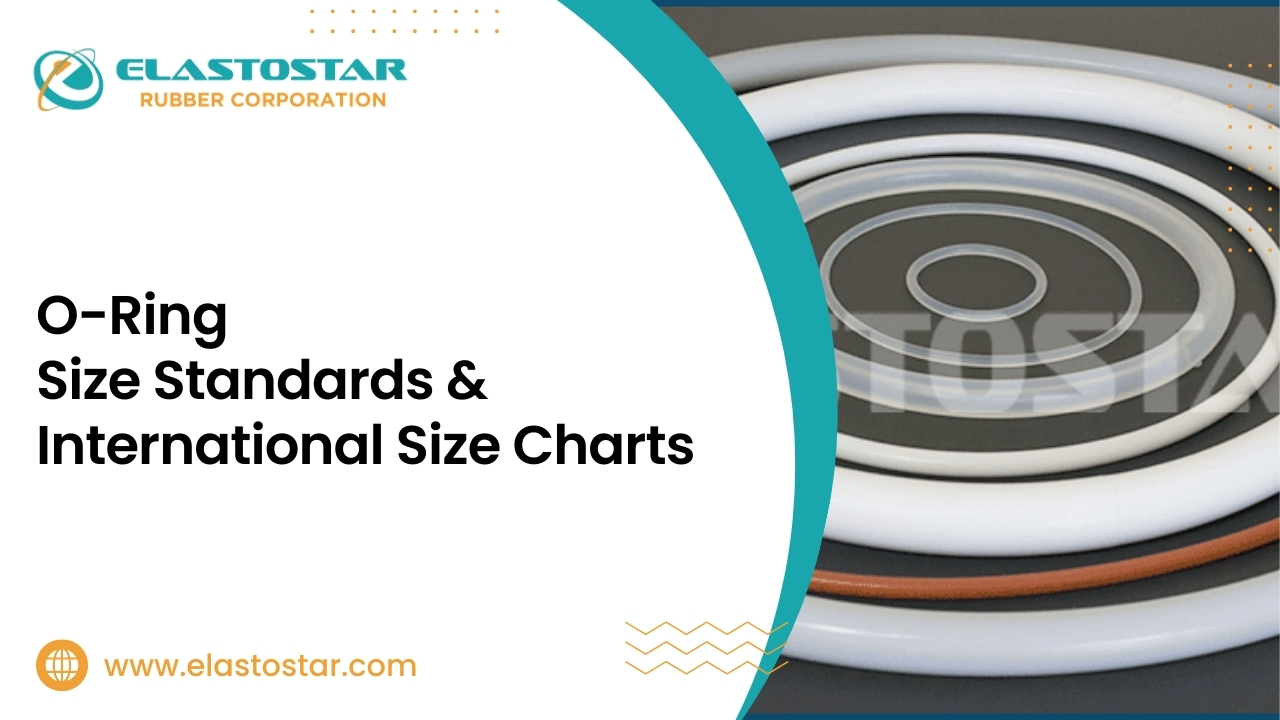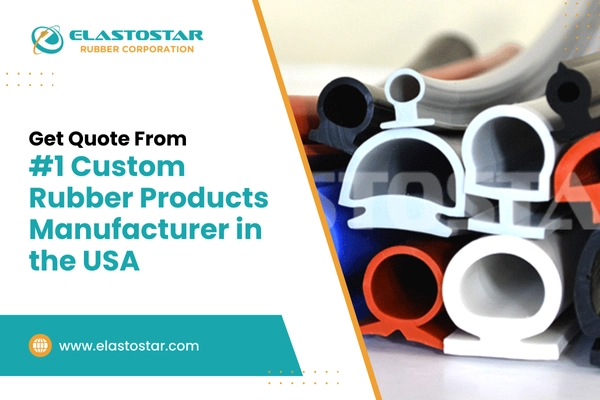Did you know that selecting the wrong O-Ring size can increase the risk of system failure by up to 70%?
O-Ring size standards ensure proper sealing in various applications, from automotive to pharmaceutical industries. By selecting the correct size using an O-Ring size chart, you can prevent leaks and keep systems running smoothly. These standards, including those for silicone rings, help maintain consistency in manufacturing and compatibility across industries worldwide.
Let’s understand the further to see how these sizes are organized and used globally.
Table of Contents
Overview of O-Ring Size Standards
1. AS568 O-Ring Standard (USA)
The AS568 O-Ring standard is widely used in the United States, setting precise specifications for O-Ring dimensions, including inner diameter, outer diameter, and cross-sectional thickness. This standard is essential for industries such as automotive, aerospace, and fluid power, ensuring proper sealing and system efficiency.
2. ISO 3601 O-Ring Standard (International)
The ISO 3601 is a globally recognized O-Ring size standard that specifies sizes for O-Rings used in fluid systems and mechanical applications. This standard is critical for maintaining compatibility across different regions and industries, providing consistent manufacturing specifications for various O-Ring sizes.
3. JIS B 2401 O-Ring Standard (Japan)
The JIS B 2401 O-Ring standard is primarily used in Japan and is essential for industries like automotive and hydraulic systems. It provides detailed specifications for O-Rings used in these industries, particularly ensuring that equipment meets strict Japanese market requirements.
| Standard | Region | Common Uses |
| AS568 | USA | Automotive, Aerospace |
| ISO 3601 | International | Fluid Systems, Mechanical |
| JIS B 2401 | Japan | Automotive, Hydraulic Systems |
How to Use O-Ring Size Charts?
1. O-Ring Size Measurement
To ensure a proper fit, it’s important to accurately measure the inner diameter (ID), outer diameter (OD), and cross-sectional thickness (CS) of an O-Ring. Using tools like calipers for the ID and OD, and a micrometer for the CS, will help you take precise measurements. Always ensure that your measurements align with the specifications provided in the O-Ring size chart for a reliable seal.
2. Understanding the Tolerances in Size Charts
O-Ring size charts also include tolerances, which are acceptable variations in O-Ring dimensions. These tolerances are crucial, especially in critical applications where even small variations could lead to leaks or failures. For example, in high-pressure systems, ensuring the O-Ring matches the tolerances in the rubber ring sizes chart is key to preventing system breakdowns.
3. Common Mistakes in Selecting O-Ring Sizes
A common mistake when selecting O-Ring sizes is misreading the chart or measuring the O-Ring incorrectly. For example, mistaking the outer diameter for the inner diameter can lead to poor sealing. Additionally, using the wrong tools can result in inaccurate measurements. Always double-check your dimensions using a reliable O-Ring chart and ensure your tools are calibrated for precision.
| Measurement Type | Description | Tool Used |
| Inner Diameter | The inside width of the O-Ring | Caliper |
| Outer Diameter | The full width across the O-Ring | Caliper |
| Cross Section | The thickness of the O-Ring | Micrometer |
By following these guidelines, you can avoid common errors and select the right silicone for O-Rings or other materials for your application.
International O-Ring Size Comparison Charts
1. Converting Between AS568 and ISO 3601
When converting O-Ring sizes between the AS568 (commonly used in the USA) and ISO 3601 (used internationally), it’s important to reference a reliable O-Ring size chart. These charts help ensure that the correct size is selected for specific applications, as even slight differences can impact sealing performance.
2. JIS B 2401 vs. ISO 3601
The JIS B 2401 standard is used primarily in Japan, whereas the ISO 3601 is recognized globally. When choosing between these standards, consider the industry and region in which the O-Rings will be used. Automotive and hydraulic systems in Japan may prefer JIS B 2401, while many other international industries follow ISO 3601.
The following table compares the sizes across all three standards, making it easier to select the right size based on your location and application needs.
| AS568 Size | ISO 3601 Size | JIS B 2401 Size |
| 210 | 5.33 × 21.95 | P-24 |
| 212 | 5.33 × 23.52 | P-26 |
| 214 | 5.33 × 26.64 | P-28 |
Applications of O-Ring Size Standards in Various Industries
1. Automotive Industry
The correct O-Ring size standards are essential in the automotive industry for sealing engine components, fuel systems, and transmissions. Ensuring the right O-Ring from a reliable O-Ring size chart helps prevent fluid leaks and maintains the efficiency of these systems. Using properly sized gasket rings ensures long-term performance under extreme conditions.
2. Aerospace
In the aerospace industry, O-Rings must meet precise size requirements to handle high pressure and temperature demands.The AS568 O-Ring standard is frequently used in aerospace applications to ensure that the seals function effectively, preventing system failures in challenging conditions.
3. Food and Pharmaceutical Industries
In the food and pharmaceutical industries, maintaining contamination-free environments is important. The use of FDA-approved O-Rings ensures both the accuracy of the O-Rings size chart and the safety of materials like rubber for rings. Properly sized O-Rings help companies meet strict industry standards, ensuring product safety and regulatory compliance.
Choosing the Right O-Rings from Elastostar
When it comes to selecting O-Rings that meet specific size standards like AS568, ISO 3601, and JIS B 2401, Elastostar Rubber Corporation offers high-quality solutions. Whether you need spliced vulcanized silicone rubber O-Rings for extreme conditions or fluorosilicone rubber O-Rings for added chemical resistance, Elastostar has the products to fit your exact requirements. With a commitment to precision and durability, our O-Rings help ensure system efficiency and reliability across industries
Recommended Reads
- A Complete Guide – What Is Rubber Silicone O-Rings?
- Know About Silicone Rubber O Ring & It’s Properties
- Custom Silicone O-Rings Leading Manufacturer In The USA And Canada

Conclusion
Knowing O-Ring size standards is important for selecting the right O-Ring in any application. Proper sizing helps prevent leaks, improves system performance, and maintains safety across various industries, including automotive, aerospace, and food processing. Referring to international size charts like AS568, ISO 3601, and JIS B 2401 helps avoid sizing errors and keeps your systems running efficiently. Always use these charts to guide your O-Ring selection for optimal results.
FAQs
- What are standard sizes for O-Rings?
Standard O-Ring sizes are specified by guidelines like AS568 in the USA, ISO 3601 internationally, and JIS B 2401 in Japan, covering inner diameter (ID), outer diameter (OD), and cross-sectional thickness (CS). - Why are O-Ring size charts important?
O-Ring size charts ensure you select the correct size for proper sealing, preventing leaks and system failures, and ensuring reliable performance. - Are ring sizes the same internationally?
No, O-Ring sizes differ internationally. The AS568 standard is used in the USA, ISO 3601 globally, and JIS B 2401 in Japan. Each region uses its own size standards. - How to calculate O-Ring size?
To calculate the size, measure the inner diameter (ID) and cross-sectional thickness (CS) using a caliper or micrometer. Use an O-Ring size chart to match these dimensions to the correct size. - What is the difference between AS568 and ISO 3601?
AS568 is used mainly in the USA with inch-based measurements, while ISO 3601 provides both metric and imperial options for global use. Elastostar Corporation offers O-Rings that meet both standards, ensuring accurate sizing for your application.



